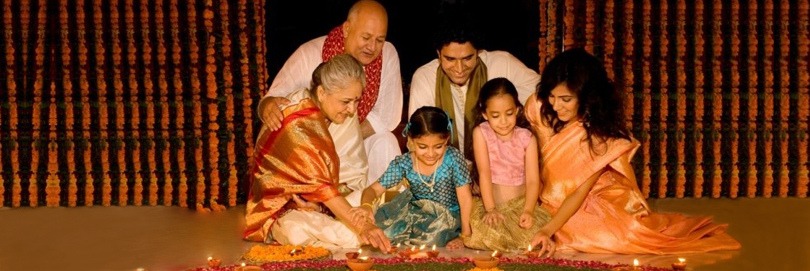Regional Significance of Diwali

The origin of Diwali festival is not known, but it has gathered a number of legends around it over the centuries. In the northern and the western regions of India, its origin is attributed to the return of Lord Ram to his kingdom after defeating the demon king Ravana. The joyous people of Ayodhya, his capital, celebrated his arrival. In the eastern states, Diwali is associated with the story of Narakasura who had menaced his people with tyranny.
In the regions of Maharashtra and Mysore, Diwali is linked with the legendary king Bali who was immensely popular with his subjects for his generosity. However, king Bali had become arrogant and conceited, and provoked the wrath of godly people. His generosity was put to test by Lord Vishnu who appeared in the disguise of a dwarf, and asked him for a piece of land equal to three steps. When Bali granted his wish, Lord Vishnu took the form of a super giant person, and with his two steps covered Bali's entire kingdom. With his third step he pushed Bali to the underland. Since then, his people celebrated his arrival on this day, locally called Bali Padyami.
In the north, most communities observe the custom of lighting lamps. However, in the south, the custom of lighting baked earthen lamps is not so much part of this festival as it is of the Karthikai celebrations a fortnight later. The lights signify a welcome to prosperity in the form of Lakshmi, and the fireworks are supposed to scare away evil spirits.
In Punjab, the day following Diwali is known as tikka when sisters make a paste with saffron and rice and place an auspicious mark on their brother's foreheads as a symbolic gesture to ward off all harm.
Likewise, on the second day of the month of Kartik, the people of Maharashtra exchange gifts. In Maharashtra, it is the thirteenth day of Ashwin, the trayodasi, that is observed as a festival commemorating a young prince whom Yama, the God of Death, had claimed four days after his marriage. Filled, however, with compassion for the luckless youth, the legend goes, Yama promised that those who observed the day would be spared untimely death-and so the lamps that are lit to mark the festival are placed facing south, unlike on other festive days, because south is the direction mythologically assigned to Yama.
For the Bengalis, it is the time to worship Goddess Kali , yet another form of Durga, the divine embodiment of supreme energy. Kali is the Goddess who takes away darkness. She cuts down all impurities, consumes all iniquities, purifies Her devotees with the sincerity of her love.
- - Diwali Cards
- - Crackers
- - Dry Fruits
Festival Fun
- Diwali Rangoli
- Diwali Messages
- Diwali SMS
- Diwali Recipes
- Deep in Diwali
- Diwali Whatsapp Messages/Status
- Tradition of Playing Cards
- Pooja Thali Decorations
- Making Diwali Cards
- Diwali Essay
- Diwali Poems
- Diwali Songs
- Diwali Mela
- Diwali Wallpapers
- Diwali Decorative Items
- Diwali 2024
- Diwali Quotes
- Lakshmi Pooja
- Articles
- Lakshmi Ganesha Mantras
- Lakshmi Chalisa
- Diwali Solar Eclipse
- Diwali Remedies
- 108 Lakshmi Names
Diwali Rangoli
Indians love colors and its perfectly reflected in various ways. Rangoli is one such example that is a unique art work that is...Know More
Diwali in History
The history of Diwali is replete with legends and these legends are moored to the stories of Hindu religious scriptures...Know More
Diwali Messages
Enjoy the Best and the Most Heartfelt Diwali Messages from all entries received by us!!...Know More
Diwali Gift Ideas
Diwali is the epiphany of showing gratefulness to the almighty for blessing with wealth and wisdom. It is the time of illuminating...Know More





